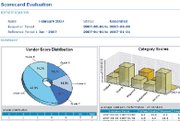TradeCard: Putting an End to the Paper Trail
Technology companies have conquered just about every element of the supply chain with IT (information technology). One area that has been somewhat overlooked is the more intangible financial supply chain. Some have tried to tackle this area of business with EDI (electronic data interchange) and other private networks, but executives at New York–based TradeCard Inc. think they have found a better way via the Internet.
When the company launched in 2003, its main goal was to create a paperless environment for companies by eliminating cumbersome letters of credit, which are often required for big international transactions.
Now, it has linked the financial supply chain with the physical one to create an end-to-end solution, having forged partnerships with some key partners.
TradeCard recently added logistics-tracking capabilities across its platform and a visibility suite to enable control of product as well as money flow.
The improvements integrate physical, financial and logistical aspects of the supply chain, providing trading partners with a full and in-depth view of their transactions.
The new release builds on the TradeCardhosted financial platform and partners Source-View’s visibility suite to encompass processes from procuring raw materials through shipment and logistics. Inbound logistics tracking is the next logical step for maintaining full control of transactions and improving the speed of trade while removing supply-chain costs.
“With TradeCard’s latest enhancements, our customers will have an unprecedented window into their supply chain,” said TradeCard Chief Executive Officer Kurt Cavano. “With one click of the mouse, you can see every place on the planet where a particular item is being touched, including details such as: ’How much is on order? How much is in process at every vendor factory and in what stage of production is it? How much is available for early shipment that I don’t own? How much is ready to ship that I own? How much is in transit and, of that amount in transit, what is its exact location? At the source port, midocean, destination port, in customs, in warehouse?’ This level of visibility allows our customers to fully implement the advanced postponement and acceleration strategies that are recommended by the next generation of demand planning systems.”
The company’s main engine still is its financial platform, which is made possible through forging hundreds of partnerships with banks, inspection bureaus, freight forwarders, logistics providers and others.
One of the key obstacles to speed has been the letters of credit involved in global transactions. They not only cost companies but take up valuable time to process, which chokes the flow of money. By leveraging its partnerships, TradeCard has been able to eliminate L/Cs for its customers.
In one case study with client TAL Apparel Ltd., the shirtmaker estimated that it was able to cut processing time of payments in half over bank-processed L/Cs. In addition to time, the company estimated that L/Cs were costing it up to $250 per transaction.
The four-week waiting period put a crimp in relationships with smaller vendors the company worked with. Now, using TradeCard, it gives all the companies’ trading partners a real time window for transactions. TAL previously used EDI to facilitate transactions as well but found that the cost of private networks associated with EDI was also taking a big chunk out of the company’s bottom line. Even with EDI, company officials were seeing errors fairly regularly, but the error ratio has been virtually nil using TradeCard.
“We’ve done this thousands of times. Everything is in the right language and in the right order,” explained Marshall Gordon, senior vice president of TradeCard.
“From a financial perspective and a physical perspective, whether it’s an ATM or grocery-store bank, it’s just streamlining the process. Once you have a foundation of elements and electronified it, all things are possible because you have the infrastructure in place. It’s a collaborative platform.”
The company’s network is comprised of more than 100 logistics providers, thousands of factories and 3,000 trading partners supported by a local customer-support team that speaks 32 languages and supports customers in 40 countries.
“If you have a problem, our guys in Asia are awake when many are sleeping,” Gordon explained. “The real measure of success is how fast you can knock down those problems. If you peel back TradeCard, it’s workflow management on steroids.” —Robert McAllister























